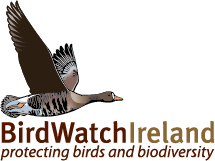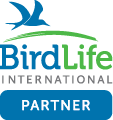Lady’s Island Lake in Co. Wexford is one of the most important tern nesting sites in Ireland and the UK. The National Parks and Wildlife Service (NPWS) have had a long-running and very successful conservation project to protect and monitor the nesting terns and gulls here, and BirdWatch Ireland were delighted to run the project again under contract in summer 2025. It’s a long season, starting back in March, and our wardens Jamie and Róisín worked closely with the NPWS staff in Wexford, particularly Conservation Ranger Pádraig Barron, throughout the summer to ensure the birds had as successful a breeding season as possible.
The islands in Lady’s Island Lake are strictly off limit to landings during the summer months, for the protection of nesting birds. Photo: Brian Burke.
The season got off to a rocky start with regular finds of dead Black-headed Gull adults. One was taken away by NPWS to be tested by the Department of Agriculture and unfortunately and it tested positive for HPAI. This colony was severely impacted by avian flu in 2023 and for it to be present so early in the breeding season was extremely worrying. Though mortality in Black-headed Gulls did continue at a low level for several weeks, thankfully only one adult Common Tern was found to have died from HPAI. Late in the summer there were clear signs that Common and Sandwich Tern chicks had been infected by HPAI and died as a result. Thankfully that happened late enough in the season that many chicks had left the colony and so the spread and impact of the virus was thankfully limited.
 One dead Tern tested positive for HPAI (bird flu) at Lady’s Island in 2025 but thankfully the overall impacts to terns was minimal. Photo: Jamie Latimer.
One dead Tern tested positive for HPAI (bird flu) at Lady’s Island in 2025 but thankfully the overall impacts to terns was minimal. Photo: Jamie Latimer.
Each of the Sandwich, Common, Arctic and Roseate Terns started nesting up to 1 week earlier than last year, possibly due to the nice weather in April and May. Nest censuses revealed that Common, Roseate and Sandwich Tern numbers increased this year by 38.5%, 1.9% and 7.7%, respectively, but Arctic Tern numbers declined by 65.6%, for unknown reasons. The status of Arctic Terns in Ireland, particularly on the east coast, has become quite precarious in recent years and they are a species we are increasingly concerned about. Amongst the gulls, Black-headed Gull numbers increased by 2.5%, but Mediterranean Gulls declined by 15%. While we are still calculating the final figures, it’s safe to say that most species seemed to have a good breeding season with reasonable levels of ‘productivity’. Arctic Terns were the exception to this however, with many chicks found dead at a young age. Again, the reasons for this are unknown.
 The presence of bird flu meant we had to enact very strict PPE protocols to continue monitoring the colony, whilst minimising any risks associated with the virus. Photo: Róisín Towe.
The presence of bird flu meant we had to enact very strict PPE protocols to continue monitoring the colony, whilst minimising any risks associated with the virus. Photo: Róisín Towe.
 Lady’s Island is the second largest Roseate Tern colony in all of Europe, and hundreds of nestboxes are deployed each year to provide suitable high-density nest space for them. Photo: Jamie Latimer.
Lady’s Island is the second largest Roseate Tern colony in all of Europe, and hundreds of nestboxes are deployed each year to provide suitable high-density nest space for them. Photo: Jamie Latimer.
 Common Terns courting at Lady’s Island in April 2025. They started nesting early this year, as did many of the other Tern species. Photo: Jamie Latimer.
Common Terns courting at Lady’s Island in April 2025. They started nesting early this year, as did many of the other Tern species. Photo: Jamie Latimer.
 Sandwich Tern chick – Lady’s Island has the largest Sandwich Tern colony in Ireland. Photo: Jamie Latimer.
Sandwich Tern chick – Lady’s Island has the largest Sandwich Tern colony in Ireland. Photo: Jamie Latimer.
Thankfully predation had a very limited impact on the nesting birds, though there were successful raids by Great Black-backed Gulls, Herring Gulls and Peregrine Falcons, and the presence of foxes at mainland locations in close proximity to the nesting islands was worrying but thankfully didn’t amount to any significant predation on terns or gulls.
On 2nd June, Tony Murray from NPWS saw some Little Terns showing signs of nesting down by ‘The Cut’. We went to investigate and found some pairs in courtship displays on a small sandy island! This was very exciting as Little Terns have only very occasionally attempted to nest at Lady’s Island, and in recent history have always failed to successfully raise chicks. They had chosen a nest site that was a popular spot for kite- and wind surfers but after talking to them they were generally happy to keep their distance from the small island and helped to spread the word amongst other surfers. The area is also popular with dog walkers and given the short distance between the nesting island and mainland there was a risk of dogs swimming out to the island. Thankfully, we spoke to any dog walkers about the Little Terns and never witnessed any dogs accessing the island. Pádraig from NPWS put up signs in the area informing people of the Little Terns nesting, which helped to reduce disturbance to them and he was able to check up on them regularly too.
 Little Terns nested on this small sandy island at Lady’s Island this year. Disturbance from dogs, wind-surfers and kite-surfers posed a real threat but thankfully the season passed without incident. Photo: Brian Burke.
Little Terns nested on this small sandy island at Lady’s Island this year. Disturbance from dogs, wind-surfers and kite-surfers posed a real threat but thankfully the season passed without incident. Photo: Brian Burke.
As the tern chicks on the main islands began to fledge, we were able to spend more time watching the Little Terns. Most of our weekends were now taken up watching them, as that was when the area was busiest with people, dog walkers and kitesurfers. Over a few weeks, we worked out that there were at least nine pairs nesting on the island. We were able to ring the chicks as they got older, and so they will contribute to the large ongoing dataset for Little Terns on the east coast of Ireland, helping to monitor their movements both outside the breeding season, and also what site they might nest at in future years and the levels of interchange between colonies. Colour-ringing of Little Terns is also carried out at Cahore (NPWS), Kilcoole (NPWS, BirdWatch Ireland), Portrane (BWI Fingal Branch) and Baltray (Louth Nature Trust) as well as many sites in the UK and Europe.
 Little Tern chicks gathered together to be ringed, under NPWS licence, before being put back in the nesting area. Photo: Brian Burke.
Little Tern chicks gathered together to be ringed, under NPWS licence, before being put back in the nesting area. Photo: Brian Burke.
 A Ringed Plover chick being released after ringing. Ringed Plover are an amber-listed species that often benefit from conservation projects targeted at species like terns. Photo: Brian Burke.
A Ringed Plover chick being released after ringing. Ringed Plover are an amber-listed species that often benefit from conservation projects targeted at species like terns. Photo: Brian Burke.
Later in July large gulls were starting to fly around the area, which was our next worry. But as the chicks of other tern and gull species in the northern part of the lake had started to fledge, the adults and fledglings were leaving their original nesting area and many had moved to the little tern island to roost and hang out during the day. So those adult terns were a great help in keeping the gulls away! As of the end of July, most of the Little Tern and Ringed Plover chicks appear to have fledged.
 Adult Little Tern coming out of the water at Lady’s Island. Photo: Jamie Latimer.
Adult Little Tern coming out of the water at Lady’s Island. Photo: Jamie Latimer.
Lady’s Island Lake in Wexford is therefore the only place in Europe to have Roseate, Common, Arctic, Sandwich and Little Terns nesting successfully at the same site! While both BirdWatch Ireland and NPWS staff were kept busy protecting the colony throughout the summer, overall it was a successful season. The continued success of Lady’s Island as one of Ireland’s premier tern and gull colonies is testament to the long-term conservation efforts by NPWS, BirdWatch Ireland, Dave Daly and a long list of former wardens and volunteers who have invested huge time and effort into it, as well as the local community around the lake who have been hugely helpful and supportive of the project.
The Lady’s Island Lake Tern Conservation Project is a National Parks and Wildlife Service project, delivered under contract in 2025 by BirdWatch Ireland.
Visit the links below for more information on NPWS’s work in Wexford and nationally.
https://www.wexfordwildfowlreserve.ie/
https://www.facebook.com/npwswexfordwildfowlreserve/




 One dead Tern tested positive for HPAI (bird flu) at Lady’s Island in 2025 but thankfully the overall impacts to terns was minimal. Photo: Jamie Latimer.
One dead Tern tested positive for HPAI (bird flu) at Lady’s Island in 2025 but thankfully the overall impacts to terns was minimal. Photo: Jamie Latimer. The presence of bird flu meant we had to enact very strict PPE protocols to continue monitoring the colony, whilst minimising any risks associated with the virus. Photo: Róisín Towe.
The presence of bird flu meant we had to enact very strict PPE protocols to continue monitoring the colony, whilst minimising any risks associated with the virus. Photo: Róisín Towe.  Lady’s Island is the second largest Roseate Tern colony in all of Europe, and hundreds of nestboxes are deployed each year to provide suitable high-density nest space for them. Photo: Jamie Latimer.
Lady’s Island is the second largest Roseate Tern colony in all of Europe, and hundreds of nestboxes are deployed each year to provide suitable high-density nest space for them. Photo: Jamie Latimer. Common Terns courting at Lady’s Island in April 2025. They started nesting early this year, as did many of the other Tern species. Photo: Jamie Latimer.
Common Terns courting at Lady’s Island in April 2025. They started nesting early this year, as did many of the other Tern species. Photo: Jamie Latimer. Sandwich Tern chick – Lady’s Island has the largest Sandwich Tern colony in Ireland. Photo: Jamie Latimer.
Sandwich Tern chick – Lady’s Island has the largest Sandwich Tern colony in Ireland. Photo: Jamie Latimer. Little Terns nested on this small sandy island at Lady’s Island this year. Disturbance from dogs, wind-surfers and kite-surfers posed a real threat but thankfully the season passed without incident. Photo: Brian Burke.
Little Terns nested on this small sandy island at Lady’s Island this year. Disturbance from dogs, wind-surfers and kite-surfers posed a real threat but thankfully the season passed without incident. Photo: Brian Burke. Little Tern chicks gathered together to be ringed, under NPWS licence, before being put back in the nesting area. Photo: Brian Burke.
Little Tern chicks gathered together to be ringed, under NPWS licence, before being put back in the nesting area. Photo: Brian Burke. A Ringed Plover chick being released after ringing. Ringed Plover are an amber-listed species that often benefit from conservation projects targeted at species like terns. Photo: Brian Burke.
A Ringed Plover chick being released after ringing. Ringed Plover are an amber-listed species that often benefit from conservation projects targeted at species like terns. Photo: Brian Burke. Adult Little Tern coming out of the water at Lady’s Island. Photo: Jamie Latimer.
Adult Little Tern coming out of the water at Lady’s Island. Photo: Jamie Latimer.